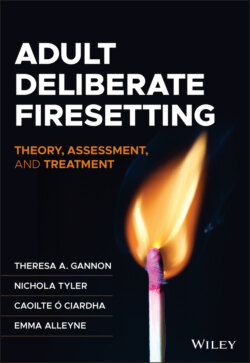Читать книгу Adult Deliberate Firesetting - Theresa A. Gannon - Страница 14
Key Developments in the Childhood Firesetting Literature
ОглавлениеThe firesetting literature has had an asymmetrical focus on children who set fires despite evidence that only half of fires are set by children (Cassel & Bernstein, 2007). There are likely to be a number of reasons for this asymmetry, including (1) a lack of awareness of the prevalence or seriousness of adult firesetting, (2) an assumption that firesetting was a fire safety and thus educational challenge, and (3) a belief that childhood firesetting may be indicative of serious and violent offending in adulthood (e.g., the “MacDonald triad”). Based on interviews with 100 residents in a psychiatric facility, MacDonald (1963) concluded that the presence of (1) enuresis (beyond 5 years of age), (2) animal cruelty, and (3) firesetting during their childhoods, taken together, was a prognostic indicator of future violence (operationalised as “threats to kill”). The clinically appealing nature of this study for diagnostic and risk assessment purposes appears to have resulted in its wide-spread and continued application (Barrow et al., 2014). This is despite MacDonald’s findings never being replicated. Instead, the evidence suggests that the presence of either animal cruelty or firesetting during childhood is more indicative of dysfunctional and abusive childhoods (i.e., environments that normalise violent behaviour) rather than violent behaviour itself (Parfitt & Alleyne, 2020).
There has since been a shift away from focussing on the firesetting–violence link towards developing the understanding of the more proximal causes of firesetting behaviour. Root et al. (2008) explain that juvenile firesetting may be the outcome of child abuse and its resulting affective and behavioural difficulties. The DSM-5 views firesetting behaviour as a feature of conduct disorder in children. That is, deliberately setting fires to destroy property (note animal cruelty as well) is a diagnostic criterion for conduct disorder—“a repetitive and persistent pattern of behaviour in which the basic rights of others … are violated” (APA, 2013).
The child literature has also offered some insight into the dynamic risk factors associated with firesetting behaviour. For example, as a result of neglectful parenting styles (Slavkin, 2000) as well as the previously mentioned abusive household environments, children and adolescents who set fires develop impoverished and unsophisticated interpersonal social abilities. These abilities form the basis of their dysfunctional attachment styles (Räsänen et al., 1996). These relational issues have since been captured in the adult literature. Most notably, adults (in particular men) who set fires exhibit signs of loneliness with limited and/or unhelpful social support networks (Rice & Harris, 2008). Maladaptive attachment styles are associated with offending more broadly (e.g., Ross & Pfäfflin, 2007; Ward et al., 1996), and their role in reinforcing offending behaviour makes them highly suitable targets for treatment in adults.
In sum, this literature tells us that childhood firesetting points to maladaptive and dysfunctional childhood environments conducive of offending behaviour. But more important, it appears that a history of firesetting behaviour during childhood may be a risk factor for future firesetting in adulthood (Ducat et al., 2015). Therefore, the firesetting behaviour itself is indicative of a developmental psychopathology that supports the use of fire as a coping strategy and/or problem-solving method. This conceptualisation has been captured in the latest theories (see Chapter 3) and has significant implications for assessment (see Chapter 4) and treatment (see Chapters 6 and 7).
